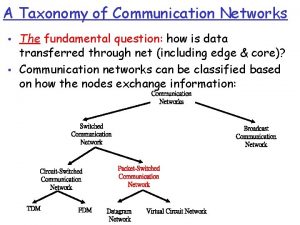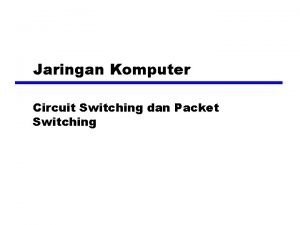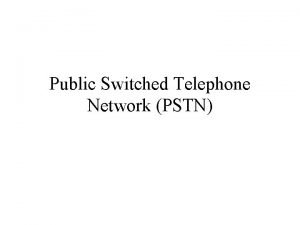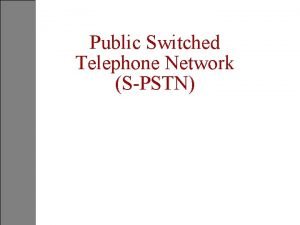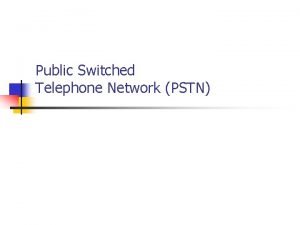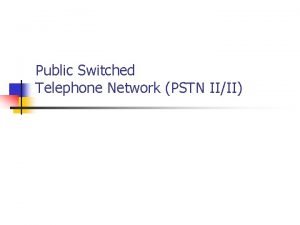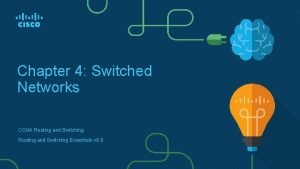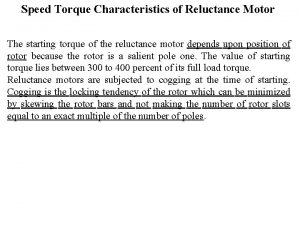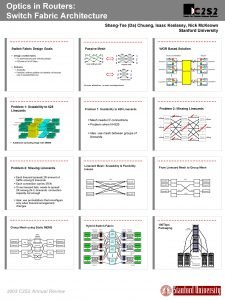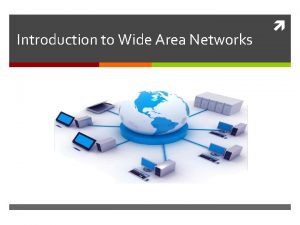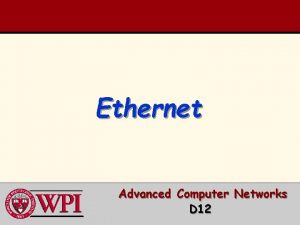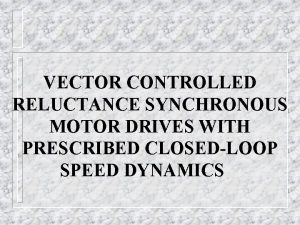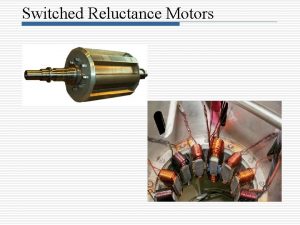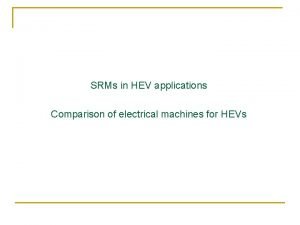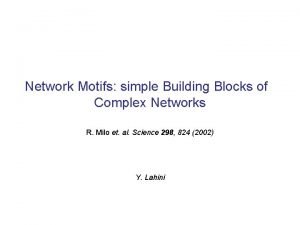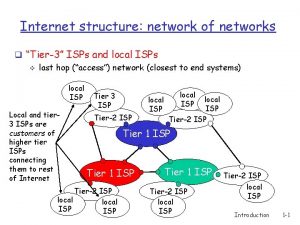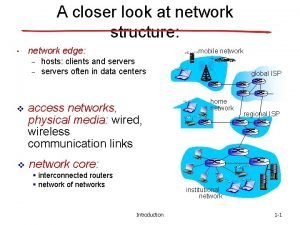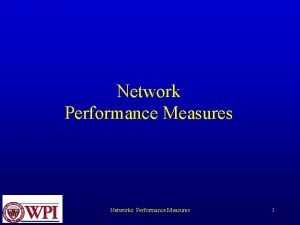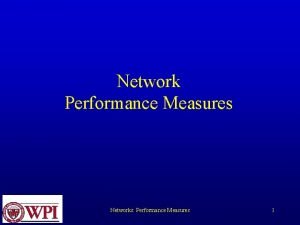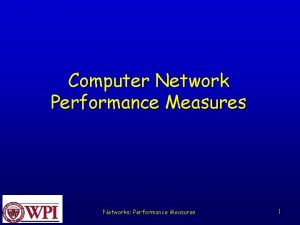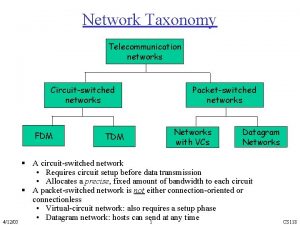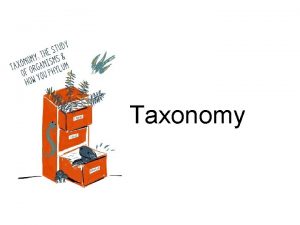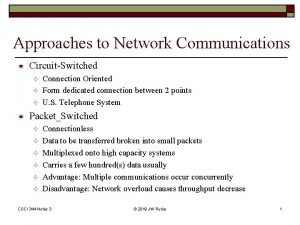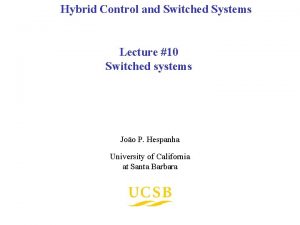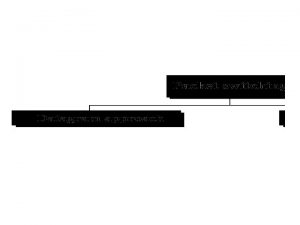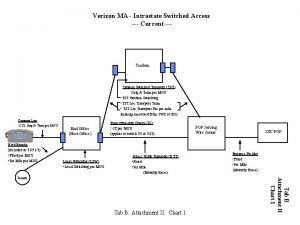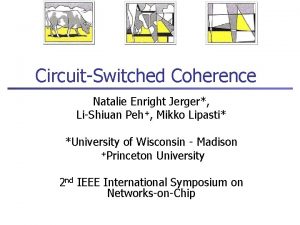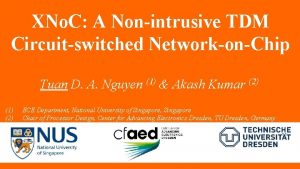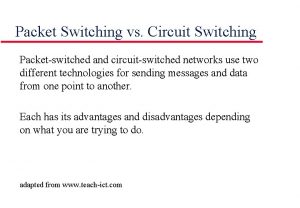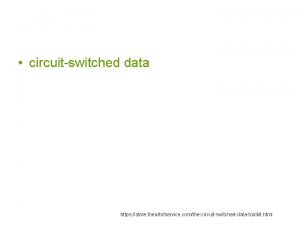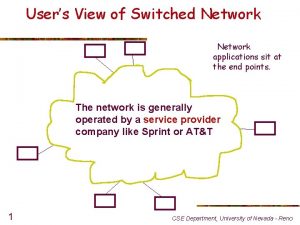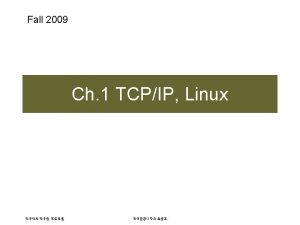Switched network Taxonomy of switched networks CIRCUITSWITCHED NETWORKS











































- Slides: 43

Switched network

Taxonomy of switched networks

CIRCUIT-SWITCHED NETWORKS A circuit-switched network consists of a set of switches connected by physical links. A connection between two stations is a dedicated path made of one or more links. However, each connection uses only one dedicated channel on each link. Each link is normally divided into n channels by using FDM or TDM.

A trivial circuit-switched network

In circuit switching, the resources need to be reserved during the setup phase; the resources remain dedicated for the entire duration of data transfer until the teardown phase. • Circuit switching takes place in Physical layer. • Data transfer between the two nodes is a continuous flow. • No addressing is involved during data transfer.

Example As a trivial example, let us use a circuit-switched network to connect eight telephones in a small area. Communication is through 4 -k. Hz voice channels. We assume that each link uses FDM to connect a maximum of two voice channels. The bandwidth of each link is then 8 k. Hz. Figure 8. 4 shows the situation. Telephone 1 is connected to telephone 7; 2 to 5; 3 to 8; and 4 to 6. Of course the situation may change when new connections are made. The switch controls the connections.

Circuit-switched network used in Example

Example As another example, consider a circuit-switched network that connects computers in two remote offices of a private company. The offices are connected using a T-1 line leased from a communication service provider. There are two 4 × 8 (4 inputs and 8 outputs) switches in this network. For each switch, four output ports are folded into the input ports to allow communication between computers in the same office. Four other output ports allow communication between the two offices.

Circuit-switched network used in Example 2

DATAGRAM NETWORKS In data communications, we need to send messages from one end system to another. If the message is going to pass through a packet-switched network, it needs to be divided into packets of fixed or variable size. The size of the packet is determined by the network and the governing protocol. In a packet-switched network, there is no resource reservation; resources are allocated on demand.

A datagram network with four switches (routers)

Routing table in a datagram network A switch in a datagram network uses a routing table that is based on the destination address. The destination address in the header of a packet in a datagram network remains the same during the entire journey of the packet. Switching in the Internet is done by using the datagram approach to packet switching at the network layer.

VIRTUAL-CIRCUIT NETWORKS A virtual-circuit network is a cross between a circuitswitched network and a datagram network. It has some characteristics of both.

Virtual-circuit identifier

Switch and tables in a virtual-circuit network

Source-to-destination data transfer in a virtual-circuit network

Setup request in a virtual-circuit network

Setup acknowledgment in a virtual-circuit network

In virtual-circuit switching, all packets belonging to the same source and destination travel the same path; but the packets may arrive at the destination with different delays if resource allocation is on demand. Switching at the data link layer in a switched WAN is normally implemented by using virtual-circuit techniques.

Message Switching • A store-and-forward network where the block of transfer is a complete message. • Since messages can be quite large, this can cause: – buffering problems – high mean delay times

Network Devices – Repeater – Hub – Bridge – Router – Gateway

Connecting Devices Networking Devices Repeaters Bridges Internetworking Devices Routers Gateways

Connecting Devices Hub

Repeater • Extend the physical length • No network function has been changed • Location is matter

Function of repeater Repeater is not same as Amplifier

Hub • Actually is a multiport repeater • Star / Tree Topology

Bridge

Bridge • Divide a large network into smaller segment • Isolating and controlling the link problems (e. g. congestion) • Regenerate signal + Checking Physical Address and forward only to the specified segment

Function of a bridge

Multiport bridge 30/ 25

Routers

Routers in an internet 32/ 25

Routers • Act like stations on a network • Multi-home • Definition (Goal) – “Learning how to get from here to there. " – “Process of discovering, selecting, and employing paths from one place to another (or to many others) in a network”

Routing Principle • Goal: Arriving at the destination • Considerations: – Direct route (shortest) – Reliable route – Cheap route – Safe route – Scenic route

Gateways (protocol converter)

A gateway SNA network (IBM) Netware network (Novell)

Other devices • • Multiprotocol routers Brouters Switches Routing switches

Single VS. Multiprotocol router

Brouter

Backbone Network Bus Backbone Star Backbone 40/ 25

Connecting Remote LAN A point-to-point link acts as a LAN in a remote backbone connected by remote bridges

Virtual LAN (VLAN) VLANs create broadcast domains

VLAN with backbone switch
 Packet switched network vs circuit switched network
Packet switched network vs circuit switched network Taxonomy communication
Taxonomy communication Pengertian packet switching
Pengertian packet switching Switched backbone networks
Switched backbone networks Introduction to switched networks
Introduction to switched networks Bcmsn
Bcmsn The new taxonomy kendall and marzano taxonomy
The new taxonomy kendall and marzano taxonomy Public switched telephone network diagram
Public switched telephone network diagram Spstn
Spstn Pstn hierarchy
Pstn hierarchy Public switched telephone network diagram
Public switched telephone network diagram Cisco borderless switched network design
Cisco borderless switched network design Vc vs datagram
Vc vs datagram Public switched telephone network notes
Public switched telephone network notes Virtual circuit switching example
Virtual circuit switching example Basestore iptv
Basestore iptv Switched on science year 4
Switched on science year 4 Sdv video
Sdv video Capacitor blrcs
Capacitor blrcs Torque speed characteristics of switched reluctance motor
Torque speed characteristics of switched reluctance motor Switch fabric architecture
Switch fabric architecture Introduction to wide area networks
Introduction to wide area networks North korea switched off case study
North korea switched off case study Switched ethernet vs shared ethernet
Switched ethernet vs shared ethernet Charge pump converter
Charge pump converter Switched on science
Switched on science Switched pdu
Switched pdu Three swiss witches audio
Three swiss witches audio Switched reluctance motor
Switched reluctance motor Switched witches
Switched witches Torque speed characteristics of switched reluctance motor
Torque speed characteristics of switched reluctance motor Hendershot
Hendershot Pcnse certificate
Pcnse certificate Principles of network applications in computer networks
Principles of network applications in computer networks Network motifs: simple building blocks of complex networks
Network motifs: simple building blocks of complex networks The network layer is concerned with
The network layer is concerned with Tier 3 isps
Tier 3 isps Internet structure network of networks
Internet structure network of networks Design issues of network layer
Design issues of network layer Network performance measurement in computer networks
Network performance measurement in computer networks Network performance measurement
Network performance measurement Network performance measurement in computer networks
Network performance measurement in computer networks Network topology in computer network
Network topology in computer network Features of peer to peer network and client server network
Features of peer to peer network and client server network

